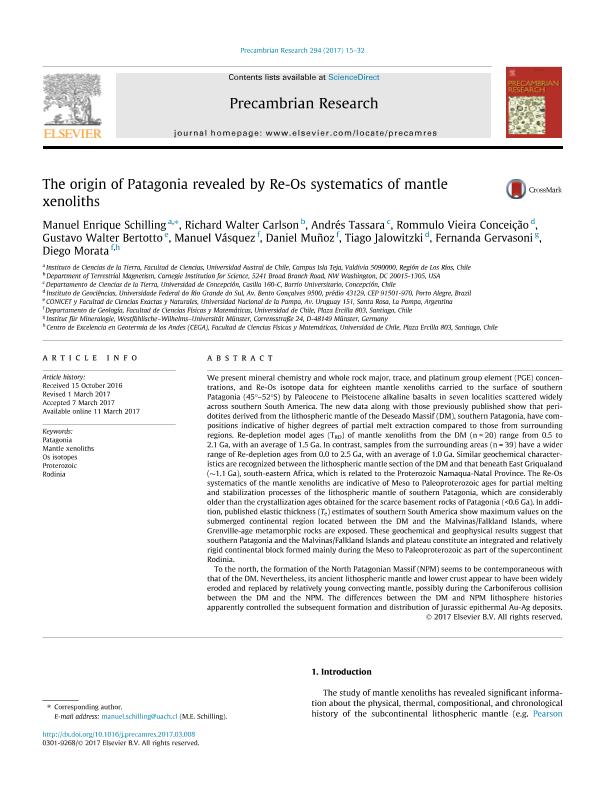Artículo
The origin of Patagonia revealed by Re-Os systematics of mantle xenoliths
Schilling, Manuel Enrique; Carlson, Richard Walter; Tassara, Andrés; Conceição, Rommulo Vieira; Bertotto, Gustavo Walter ; Vásquez, Manuel; Muñoz, Daniel; Jalowitzki, Tiago; Gervasoni, Fernanda
; Vásquez, Manuel; Muñoz, Daniel; Jalowitzki, Tiago; Gervasoni, Fernanda
 ; Vásquez, Manuel; Muñoz, Daniel; Jalowitzki, Tiago; Gervasoni, Fernanda
; Vásquez, Manuel; Muñoz, Daniel; Jalowitzki, Tiago; Gervasoni, Fernanda
Fecha de publicación:
06/2017
Editorial:
Elsevier Science
Revista:
Precambrian Research
ISSN:
0301-9268
Idioma:
Inglés
Tipo de recurso:
Artículo publicado
Clasificación temática:
Resumen
We present mineral chemistry and whole rock major, trace, and platinum group element (PGE) concentrations, and Re-Os isotope data for eighteen mantle xenoliths carried to the surface of southern Patagonia (45°–52°S) by Paleocene to Pleistocene alkaline basalts in seven localities scattered widely across southern South America. The new data along with those previously published show that peridotites derived from the lithospheric mantle of the Deseado Massif (DM), southern Patagonia, have compositions indicative of higher degrees of partial melt extraction compared to those from surrounding regions. Re-depletion model ages (TRD) of mantle xenoliths from the DM (n = 20) range from 0.5 to 2.1 Ga, with an average of 1.5 Ga. In contrast, samples from the surrounding areas (n = 39) have a wider range of Re-depletion ages from 0.0 to 2.5 Ga, with an average of 1.0 Ga. Similar geochemical characteristics are recognized between the lithospheric mantle section of the DM and that beneath East Griqualand (∼1.1 Ga), south-eastern Africa, which is related to the Proterozoic Namaqua-Natal Province. The Re-Os systematics of the mantle xenoliths are indicative of Meso to Paleoproterozoic ages for partial melting and stabilization processes of the lithospheric mantle of southern Patagonia, which are considerably older than the crystallization ages obtained for the scarce basement rocks of Patagonia (<0.6 Ga). In addition, published elastic thickness (Te) estimates of southern South America show maximum values on the submerged continental region located between the DM and the Malvinas/Falkland Islands, where Grenville-age metamorphic rocks are exposed. These geochemical and geophysical results suggest that southern Patagonia and the Malvinas/Falkland Islands and plateau constitute an integrated and relatively rigid continental block formed mainly during the Meso to Paleoproterozoic as part of the supercontinent Rodinia. To the north, the formation of the North Patagonian Massif (NPM) seems to be contemporaneous with that of the DM. Nevertheless, its ancient lithospheric mantle and lower crust appear to have been widely eroded and replaced by relatively young convecting mantle, possibly during the Carboniferous collision between the DM and the NPM. The differences between the DM and NPM lithosphere histories apparently controlled the subsequent formation and distribution of Jurassic epithermal Au-Ag deposits.
Palabras clave:
Patagonia
,
Mantle Xenoliths
,
Os Isotopes
,
Proterozoic
,
Rodinia
Archivos asociados
Licencia
Identificadores
Colecciones
Articulos(INCITAP)
Articulos de INST.D/CS D/L/TIERRA Y AMBIENTALES D/L/PAMPA
Articulos de INST.D/CS D/L/TIERRA Y AMBIENTALES D/L/PAMPA
Citación
Schilling, Manuel Enrique; Carlson, Richard Walter; Tassara, Andrés; Conceição, Rommulo Vieira; Bertotto, Gustavo Walter; et al.; The origin of Patagonia revealed by Re-Os systematics of mantle xenoliths; Elsevier Science; Precambrian Research; 294; 6-2017; 15-32
Compartir
Altmétricas



